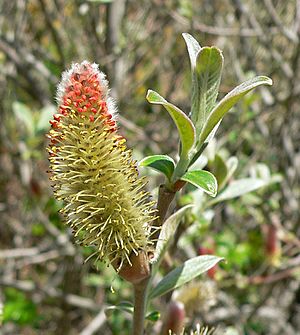Del Norte willow facts for kids
Quick facts for kids Del Norte willow |
|
|---|---|
 |
|
| Scientific classification | |
| Genus: |
Salix
|
| Species: |
delnortensis
|
The Salix delnortensis, also known as the Del Norte willow, is a special kind of willow plant. It's a shrub that grows in certain parts of North America. This plant is named after Del Norte County in California, where it is often found.
Where Does the Del Norte Willow Live?
This willow plant is found only in a specific area: the Klamath Mountains. These mountains are located in the northwestern part of California and the southwestern part of Oregon. When a plant or animal is found only in one specific place, we say it is endemic to that area.
The Del Norte willow likes to grow in special kinds of soil called serpentine soils. It also prefers areas near water, like riverbanks or streams, which are called riparian zones. You can find it growing in mixed evergreen forests at elevations between 90 and 500 meters (about 295 to 1,640 feet) above sea level.
What Does the Del Norte Willow Look Like?
The Salix delnortensis is a shrub that usually grows about 1 to 2 meters (3 to 6.5 feet) tall. It often forms thick groups of plants, sometimes quite large. Many of these groups are actually made up of clones, meaning they are exact copies of one original plant.
This shrub has many branches, but they can be quite fragile and break easily. When the twigs are young, they feel soft and fuzzy because they are covered in tiny hairs. As they get older, the branches become smooth and hairless.
The leaves of the Del Norte willow are oval-shaped and can have pointed tips. They have smooth edges and feel woolly on their undersides. These leaves can grow quite long, sometimes over 10 centimeters (about 4 inches).
Before the leaves fully appear, the plant produces its flowers. These flowers grow in structures called catkins. Male catkins are about 3 centimeters (1.2 inches) long and thick, while female catkins can be different sizes. The Del Norte willow usually blooms in April and May.
See also
 In Spanish: Salix delnortensis para niños
In Spanish: Salix delnortensis para niños

